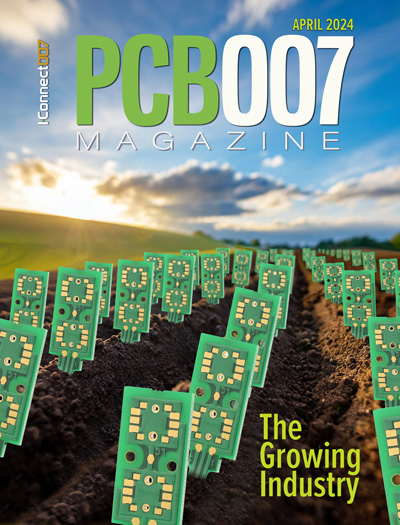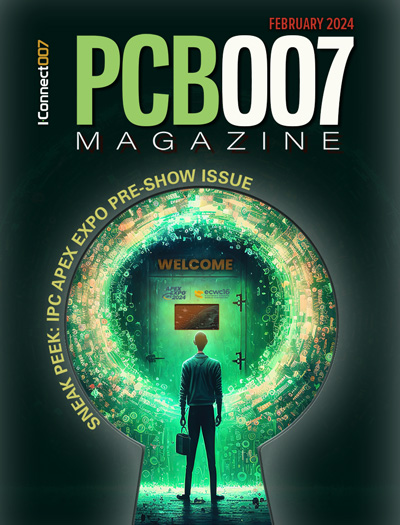-

- News
- Books
Featured Books
- pcb007 Magazine
Latest Issues
Current Issue
The Growing Industry
In this issue of PCB007 Magazine, we talk with leading economic experts, advocacy specialists in Washington, D.C., and PCB company leadership to get a well-rounded picture of what’s happening in the industry today. Don’t miss it.

The Sustainability Issue
Sustainability is one of the most widely used terms in business today, especially for electronics and manufacturing but what does it mean to you? We explore the environmental, business, and economic impacts.

The Fabricator’s Guide to IPC APEX EXPO
This issue previews many of the important events taking place at this year's show and highlights some changes and opportunities. So, buckle up. We are counting down to IPC APEX EXPO 2024.
- Articles
Article Highlights
- Columns
Search Console
- Links
- Events
||| MENU - pcb007 Magazine
Round Robin of High-Frequency Test Methods by IPC-D24C Task Group (Part 1)
July 22, 2016 | Glenn Oliver, Jonathan Weldon, et al. DUPONT*Estimated reading time: 1 minute
This paper was originally published in the proceedings of IPC APEX EXPO, Las Vegas, Nevada, February 2016. It won the Best Paper Award for the conference.
Abstract
Currently there is no industry standard test method for measuring dielectric properties of circuit board materials at frequencies greater than about 10 GHz. Various materials vendors and test labs take different approaches to determine these properties. It is common for these different approaches to yield varying values of key properties like permittivity and loss tangent. The D-24C Task Group of IPC has developed this round robin program to assess these various methods from the “bottom up” to determine if standardized methods can be agreed upon to provide the industry with more accurate and valid characteristics of dielectrics used in high-frequency and high-speed applications.
Problem Statement
Accurate values of relative permittivity (ɛr) and loss tangent (tan δ) are important characteristics for designers and fabricators in predicting electrical performance of circuits at high frequencies[1]. The most common method for evaluating these parameters at frequencies up to 10 GHz is described in IPC-TM-650-2.5.5.5[2]. This method is equivalent to ASTM-D-3380[3]. This method excites a stripline resonator at both ends with the dielectric under test comprising most of the volume. The stripline is created by establishing intimate contact using a constant clamp force. This method is highly repeatable and is optimized for QA testing at a specific frequency. This method is not well suited for characterizing at frequencies higher than 10 GHz.
To read this entire article, which appeared in the July 2016 issue of The PCB Magazine, click here.
Suggested Items
Stan Rak: Elevating the Ideas and Insights of IPC's Thought Leaders Program
04/25/2024 | Stanton Rak, SF Rak CompanyAs a member of the IPC Thought Leaders Program (TLP), I am responsible for identifying knowledge-sharing opportunities that can generate ideas and insights that strengthen the IPC community as well as create a sustainable and lasting future for its members. I am delighted to highlight some of my recent contributions as a member of the TLP.
Alternative Manufacturing Inc. Awarded QML Requalification to IPC J-STD-001 and IPC-A-610
04/24/2024 | IPCIPC's Validation Services Program has awarded an IPC J-STD-001 and IPC-A-610 Qualified Manufacturers Listing (QML) requalification to Alternative Manufacturing Inc (AMI).
IPC Design Competition Champion Crowned at IPC APEX EXPO 2024
04/24/2024 | IPCAt IPC APEX EXPO 2024 in Anaheim, California, five competitors squared off to determine who was the best of the best at PCB design.
Big Win for Defense Production Act Budget Allocation in FY24 Budget
04/23/2024 | I-Connect007 Editorial TeamOne year ago, President Biden issued a determination that chips and packaging are critical for national security. Since that time, much work has been done to continue the conversation in Washington, elevating the importance of the entire chips value chain, and including printed circuit boards and substrates, without which chips cannot operate.
Real Time with... IPC APEX EXPO 2024: A Conversation with IPC's CEO: New Venue, Sustainability, and More
04/23/2024 | Real Time with...IPC APEX EXPOBarry Matties hosts Dr. John W. Mitchell, CEO of IPC, on the final day of IPC APEX EXPO 2024. They discuss the new venue in Anaheim and broach a range of topics, from traffic and booth experiences to workforce development, sustainability, and the CHIPS Act. And they offer advice for newcomers as IPC looks forward to an even better show experience next year.


